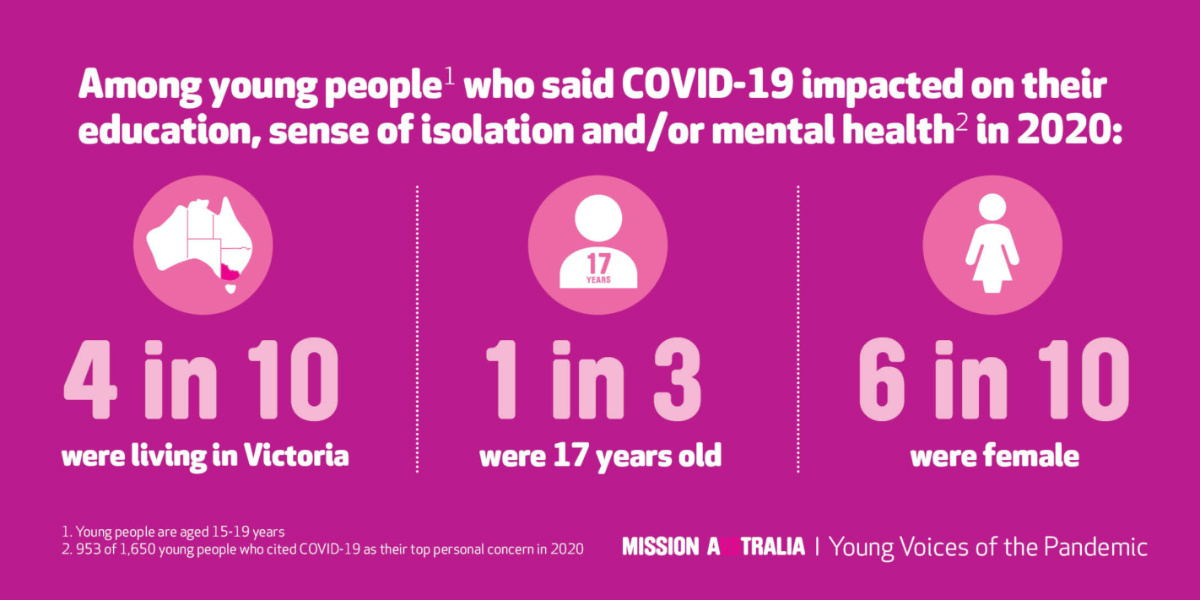Sydney, Australia
Teenagers across Australia are suffering from increased anxiety about their education, experience of isolation, mental health and future prospects due to the COVID-19 pandemic, the annual Mission Australia report on youth says.
The Young Voices of the Pandemic: Youth Survey COVID Report 2020, released on Wednesday, shows amongst those reporting personal concerns, 58.7 per cent were females, compared to 34.5 per cent males.

Most lived in Victoria (38.2 per cent) which was subject to longer lockdown restrictions last year, impacting their schooling and social lives, while among respondents, the largest proportion were 17-years-old (35.9 per cent).
“Our report highlights that among the young people who reported that COVID-19 was the biggest issue they had been facing, young Victorians were more likely to be concerned about their education, isolation and mental health than peers from other states and territories,” Mission Australia CEO James Toomey said.

James Toomey, CEO of Mission Australia. PICTURE: Supplied.
“Our report highlights that among the young people who reported that COVID-19 was the biggest issue they had been facing, young Victorians were more likely to be concerned about their education, isolation and mental health than peers from other states and territories.”
– James Toomey, CEO of Mission Australia.
“It confirmed something we had suspected anecdotally through our staff on the ground. We had heard throughout the year that young people – particularly young people who were preparing for their end of year exams- had found last year pretty difficult,” he told Sight.
The survey asked 25,800 students aged 15 to 19 a range of questions between April and August, with 18,486 responding to the question about the biggest issue that had affected them that year and what they felt should be done about it.
“We are very concerned that the impact of this virus will continue to have flow-on effects on young people’s lives now, and their futures. To best support our young people and mitigate any negative consequences they may face due to the pandemic, we must begin by listening to them and ensure that the right supports and systems are in place,” Toomey said.
Among solutions put forward for implementation by young people were:
• Support for young people to understand when and how to help themselves when feeling overwhelmed and stressed with study, when feeling isolated and when experiencing poor mental wellbeing.
• Extra support for young people in schools to support their wellbeing and in completing final years of school during COVID-19 restrictions to make sure they can achieve their educational goals.
• Mental health prevention and early intervention supports delivered in flexible formats to address wellbeing issues that may arise during isolation periods.
• More services and resources to support the mental wellbeing of young people, including through schools and outreach programs. Among the frequently recorded responses in the report, were students’ anxieties about poor performance, lower grades and an uncertain future.
One 18-year old Victorian student said his biggest issue was online schooling. “I feel as if not having physical contact and being withheld from a learning environment has affected my studying and learning capability.”
Another 17-year-old student in NSW said she and her peers were being asked too much to continue the same curriculum and the same workload that previous students have had without online learning and a pandemic to deal with.
“We are expected to be functioning as normal, but we are not in a normal school/world environment.”
Toomey said continuing to break down the stigma and barriers surrounding mental health, as well as improving access to mental health programs and supports, and normalising it within society would help the cohort into the future.
He said end of school results achieved by last year’s Year 12 cohort did not tell the full picture of how the pandemic affected students, with many not completing studies, however, there was “hope” for the class of 2021 and beyond.
“It shows what is possible in that situation. It is possible to maintain their learning trajectory over a period where there’s a lot of disruption happening in their lives and that is very useful, but that is one lens on what happened last year.”
He said if looked at purely from the point of view of academic attainment, it could be argued it (the cohort) was not negatively impacted, but some students would have dropped out entirely and other stressors, including feelings of isolation also needed to be considered. He said mental health issues, psychological distress and anxiety are the things that can show up for years as people become adults, and may well manifest itself years from now in terms of whole lifetime attainment.
“We have to be alert to the possibility that this is a cohort of young people who might have heightened presentations of mental illness or psychological distress or trauma, compared to other similar cohorts who haven’t been through this experience.”
Toomey said government, business and higher education organisations all had a part to play in assisting teenagers affected by mental distress and anxiety caused by the pandemic as they entered adulthood.
“This is a whole of society problem. It’s a whole of community problem that we are facing in terms of the response and how we come out of this,” he said. “There isn’t going to be a single silver bullet that fixes everything.
“We are saying, ‘there is a whole person there, we need to be taking account of the whole person’.”
Other groups that had a part to play included faith-based groups and sporting groups in talking about and supporting mental health issues.





